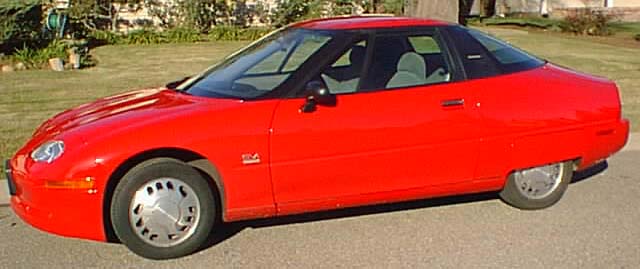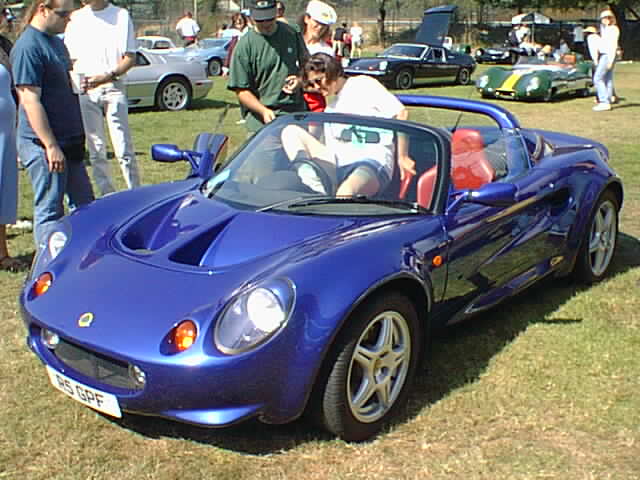What are Hypercars?
In 1993, the
Rocky Mountain Institute
coined term Hypercar
to refer to ultra-modern, extremely-efficient cars which offer
outstandingly clean, safe and economical high performance.
Specifically RMI believes hypercars can "achieve 3 to 5-fold
improvement in fuel economy, equal or better performance, safety,
amenity and affordability, compared to today's vehicles."
What are some characteristics of hypercars?
Hypercars have very efficient propulsion, weight-efficient construction,
and outstanding aerodynamics. While any one of these
characteristics alone can create good performance, when all three
are combined the resulting hypercars can exceed
typical Autobahn speeds, offer good handling,
and achieve astounding fuel economy.
Do hypercars exist yet?
While there are no hypercars currently in production,
many features of hypercars have been incorporated into
advanced technology prototypes, show cars, hybrid and
electric vehicles.

For example the General Motors
EV1 (pictured above),
Precept
and
Opel Eco Speedster
feature outstanding aerodynamics with drag coefficients
vastly lower than current production cars.
For example, the coefficient of drag of these cars
respectively is 0.19, 0.16 and 0.20.
In comparison, the best production cars today have
a coefficient of drag at around 0.30 or about 50% to 100% worse.
Drag decreases speed and efficiency, and it wastes both
fuel and energy.
Once designed in, low drag saves energy and fuel and increases
efficiency with no recurring or additional costs.

Light, strong, rigid and safe chassis are features of the GM
Ultralite
technology demonstrator, the Aluminum chassis of the production
Lotus
Elise
(pictured above)
and the Elise-based Opel Eco Speedster show car.
The
Eco Speedster
also uses an very efficient
turbocharged, direct-injected diesel engine to achieve
94 miles per gallon fuel efficiency together with a 155 mile per hour
top speed. The Eco Speedster is perhaps the closest
anyone has come to creating a hypercar which is fully
produceable today at a retail price near $30,000.
Tesla Motors'
Roadster is essentially an electric Elise. With all best-of-breed
Lotus Aluminum chassis and handling, Carbon-fiber bodywork, an AC Propulsion-based
electric drive system and Tesla's own Lithium-Ion battery system,
it should offer energy efficiency in excess of 100 MPG.
(Toyota's RAV4 EV, an electric version of their SUV, is rated at 100 MPG
equivalent energy efficiency by the U.S. Federal Government's EPA. The Tesla
Roadster, by virtue of its smaller size and lighter weight is even more efficient.
Like a hypercar, it also offers extremely high performance.
Doing 0-60 MPH in about 4 seconds,
the Tesla Roadster is quicker than most Ferraris and Porsches.)
If
Aptera
goes into production it will arguably be a hypercar.
It's a composite three wheeler with low drag and low mass.
Claimed energy usage is about 60 Watt-hours per kilometer or about 97
Watt-hours per mile, which works out to about 380 MPG on electricity.
Energy usage on gasoline is much higher due to the inefficiencies of
internal combustion engines at about 130 MPG or about 282 Watt-hours
per mile.
Initial version is electric with a gasoline hybrid to follow.
It has a claimed drag coefficient of 0.11, which is outstanding.
Unveiled at the 2003 Tokyo Motor Show,
Honda's
IMAS features
an aluminum frame, carbon fiber bodywork and power by Honda's
hybrid gasoline/electric IMA drive system.
Claimed weight is 700 kg or 1540 pounds with a
drag coefficient of 0.20 and 40km/l or 94 MPG fuel efficiency. If Honda
would produce a car like IMAS, it would offer near-hypercar performance.
Concept
Carz coverage of IMAS includes many photos.
Other running prototypes at least partially addressing the hypercar idea include
the 2001
Daihatsu UFE
and 2002
Volkswagen
L1
which attain high fuel economy, light weight and good performance.
The L1's name derives from the fact that it
consumes 1 liter per 100 kilometers which is 239 miles per
gallon, while the UFE gets 130 miles per gallon on a standard
Japanese mileage test.
Daihatsu showed a second generation
UFE-2 at the
2003 Tokyo Motor Show. It features a claimed drag coefficient of 0.19 and
fuel efficiency of 60 km per liter or 143 miles per gallon.
The 2005 UFE-III
is a 440 kg gasoline-electric hybrid with claimed 72 km/l and 0.168 Cd.
That's 970 pounds and 169 MPG.
Volkswagen's
2009
version of the L1 uses
1.38
liters of diesel fuel
to go 100 km, so it's not actually a 1 liter car, but it's good
to see continued development, even if it's less efficient than the
2002 version.
Other specs include 381 kg (840 lbs) weight, 0.8 liter two-cylinder TDI engine,
10 kw (13 horsepower) electric motor for hybrid operation, DSG gearbox.
Volkswagen's
2011 XL1
is a continued development, this time with staggered
side-by-side seating in a Carbon fiber monocoque with
a claimed drag coefficient of 0.186.
About the same length and width as a Polo,
mass is about 795 kg or about 1750 pounds.
XL1 is a plug-in hybrid with a 0.8 liter, 35 kW (48 horsepower)
two-cylinder TDI turbodiesel and a
20 kW (27 horsepower) electric motor with 5 kWh Lithium Ion battery pack,
coupled to a 7 speed DSG (dual clutch) gearbox.
Electric range is about 35 km (22 miles).
MPG is about 261 on the EU NEDC driving cycle.
The claimed fuel consumption of 0.9 liters per 100 km is complicated by
the addition of electric energy which motivates some of the
distance travelled.
CO2 emissions is quoted at 24 g/km,
with the contribution of electric energy unclear.
Popular Mechanics and other sites have more information about
XL1.
VW claims it will produce the XL1, but Aluminum or steel would be much less
epensive than Carbon fiber, even with the advanced Resin Transfer
Moulding process which VW developed.
VW says the new transfer molding process reduces cost by about 50%,
but the Carbon fiber vehicle is still 20 times more expensive than Aluminum.
Production cars like the Honda Civic Hybrid, Toyota Prius,
and Honda Insight offer hybrid drivetrains that use
both gasoline engines and electric motors to significantly
increase efficiency, especially during stop-and-go city driving.
Like battery-powered, pure-electric cars, these hybrids
also make use of regenerative braking, which recovers
some of the vast energy normally wasted as heat during braking.
Regenerative braking works by using a hybrid car's electric motor
as a generator to charge the batteries while slowing the car
during braking. That stored energy is then used later to accelerate
the car. None of these hybrids can be charged from the electric
grid. Their only energy source is gasoline.
None of the 2003 Honda or Toyota hybrids could be
considered hypercars, though the out-of-production Insight comes closest
with 50 to 70 miles per gallon possible.
The Civic Hybrid is perhaps the best integrated
of the current hybrids, and the Toyota Prius the most successful with
more than 150,000 of the initial version sold
throughout the world from 1997 through 2003.
Toyota's second-generation 2004 Prius is an improvement
over the first model, and has moved from hand assembly to
one of Toyota's highly-automated production lines.
Along with this move comes reported profitability.
Other forms of regenerative braking that have been demonstrated
or are being researched include hydraulic storage of recovered
braking energy, and
compressed
air. The latter is perhaps the
most interesting since an automobile engine is fundamentally an
air compressor. During braking the engine pumps air into
a tank. Accelerating from a stop or at low speeds,
the compressed air is released back into the engine to turn
it, thus moving the car without any fuel being used.
When more acceleration is needed or the compressed air runs out,
the engine returns to normal, fueled operation.
Meaningful measurements?
A wide variety of measurements and terms are used to describe road
vehicle efficiency. "Fuel economy", "fuel consumption" all purport
to measure how efficiently a vehicle uses energy under some standardized
conditions.
In the U.S. and U.K., the typical measurement is miles per gallon.
(However U.K. uses the larger Imperial Gallon at 4.54 liters,
while a U.S. Gallon is 3.78 liters.)
On the European continent liters per hundred kilometers is common.
A different measurement of Watt-hours per mile or kilometer is commonly
used for electric vehicles including fuel cell electric vehicles.
However Watt-hours per distance is also well-suited to describing
the energy efficiency of internal combustion vehicles,
and it allows meaningful comparisons across
vehicles with different types of propulsion and energy sources.
In the calculations below a U.S. gallon of gasoline is standardized to
contain 36,650 Watt-hours of energy, and there are 3.78 liters per gallon.
(So there are nearly 10 kWh per liter of gasoline.)
Internal combustion engines typically waste about 80% of the energy in
their fuel as useless heat.
(In the U.S., the agency the regulates such things, EPA, uses 33.7 kWh
per gallon of gasoline. Rather than converting the numbers in the table below
to their standard, I've used Watt-hour per mile numbers given
in the official figures and calculated MPG based on 36.65 kilowatt-hours
per gallon of gasoline.)
Other measures include kWh/100km (kilowatt hours per 100 kilometers),
kJ/km (kilojoules per kilometer),
MJ/km (megajoules per kilometer),
km/liter (kilometers per liter of gasoline equivalent).
Another is km/MJ (kilometers per megajoule).
Since one joule is one Watt-second,
one kilowatt-hour is 3.6 megajoules.
Given that joules are the official SI unit of energy, joules per distance
e.g. kilojoules per kilometer
may be scientifically preferrable to Watt-hours per distance, however
consumers are probably most accustomed to buying electric energy
from their electric utility in kilowatt-hours.
Another issue is that U.S. miles are shorter than U.K. miles,
so figures using miles may not be easily comparable.
Kilometers are unambiguous.
Most prototype fuel cell electric vehicles use more
than 1000 Watt-hours per mile.
Production battery electric vehicles use about 200 to 300 Watt-hours per mile.
A stock, gasoline, 2005 Chevrolet Equinox SUV uses
1500
Watt-hours per mile at 24 MPG.
A depletion-mode, plug-in hybrid version of the Equinox uses
330 Watt-hours per mile.
A Prius at 46 MPG uses about 800 Watt-hours per mile.
Cal Car's Plug-In Prius uses about 260 Watt-hours per (electric mode) mile
or 141 MPG.
The Tesla Roadster pure electric sports car uses about 217 Watt-hours per mile
(169 MPG).
The Toyota RAV4 EV pure electric SUV uses about 300 Watt-hours per mile
(120 MPG).
C. Michael Lewis' 2008
Electrathon
racer used about 1000 Watts to cover about 53 miles in
one hour. That's about 19 Watt-hours per mile (1,940 MPG).
PAC-CAR II did the equivalent of 5,385 km/l of gasoline or
12,665 MPG or 5385 km (3346 miles) from 9,696 Watt-hours,
which works out to about 2.9 Watt-hours per mile.
It weighed about 30 kg fully-fueled, without driver.
Drag coefficient of the actual car measured in a wind tunnel was 0.075.
Other cars in the
Shell Eco-Marathon
routinely (though requiring great technical effort)
achieve 2000-4000 MPG or 20 to 10 Watt-hours per mile.
One problem with the numbers above is that while they measure vehicle
efficiency, they don't measure the efficiency of the energy source.
Electric generation is about 50% efficient from the most modern turbines.
Electric energy delivered to your home or office is about 40% efficient.
Oil and gasoline production, transportation, etc., require large amounts
of energy in order to get the finished product to the gas station.
(Note that this ignores the environmental costs of fossil fuels.)
Hydrogen for fuel cells is commonly made from the steam reformation
of natural gas, which extracts Carbon from fossil fuels.
Producing Hydrogen from the electrolysis of water typically uses twice
as much energy as the resulting fuel itself contains.
Fuel cell vehicles are also relatively inefficient.
Battery electric vehicles use electric energy in a more direct and
efficient way.
When
"well-to-wheels"
efficiency is measured to capture the complete
energy impact, battery electric vehicles are the most efficient
and result in the least greenhouse gasses, even when charged from
coal-fired power plants.
When charged from modern natural gas power plants the results are better.
Electricity can be made even cleaner from wind, solar, etc.

